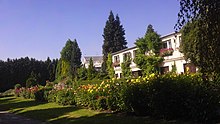Maria Curie-Skłodowska University
Uniwersytet Marii Curie-Skłodowskiej w Lublinie | |
 | |
| Established | October 23, 1944 |
|---|---|
| Rector | prof. Radosław Dobrowolski |
| Students | 25,192[1] |
| Address | Pl. M. Curie-Skłodowskiej 5, 20-031 , , |
| Affiliations |
|
| Website | www |
Maria Curie-Skłodowska University (MCSU) (Template:Lang-pl, UMCS) was founded October 23, 1944 in Lublin. It is named in honour of Marie Curie-Sklodowska. Currently the number of students is almost 36,000. The university has 302 professors (157 full professors), 231 habilitated doctors, 826 senior lecturers, and 1829 teachers in total. Total staff is 3628. To meet the growing demand for higher education, the university has established branches in other cities.
Rankings
In 2011 the Polish national daily newspaper Rzeczpospolita ranked the university 11th among Polish public universities (25).
Faculties
- Arts
- Biology and Biotechnology
- Chemistry
- Economics
- Geosciences and Land Management
- Philosophy and Sociology
- Humanities
- Mathematics, Physics and Computer Science
- Pedagogy and Psychology
- Political Science and Journalism
- Law and Administration
- Off-Campus Branch in Pulawy
Notable alumni
- Henryk Cioch (1951–2017), lawyer
- Zyta Gilowska (1949–2016), economist and politician
- Stanisław Michalkiewicz (born 1947), politician and activist
- Maciej Płaza (born 1976), writer and translator
- Jarosław Stawiarski (born 1963), politician
- Roman Szporluk (born 1933), Ukrainian and American historian, professor emeritus, doctor of historical sciences
Publications
The university publishes the following journals:[2]
- Acta Humana (ISSN 2082-4459)
- Annales Universitatis Mariae Curie-Sklodowska
- sectio A – Mathematica (ISSN 0365-1029)
- sectio AA – Chemia (ISSN 0137-6853
- sectio AAA – Physica (ISSN 0137-6861)
- sectio B – Geographia, Geologia, Mineralogia et Petrographia (ISSN 0137-1983)
- sectio C – Biologia (ISSN 0066-2232)
- sectio F – Historia (ISSN 0239-4251)
- sectio FF – Philologiae (ISSN 0239-426X)
- sectio G – Ius (ISSN 0458-4317)
- sectio H – Oeconomia (ISSN 0459-9586)
- sectio I – Philosophia-Sociologia (ISSN 0137-2025)
- sectio J – Paedagogia-Psychologia (ISSN 0867-2040)
- sectio K – Politologia (ISSN 1428-9512)
- sectio L – Artes (ISSN 1732-1352)
- sectio M – Balcaniensis et Carpathiensis (ISSN 2450-6354)
- sectio N – Educatio Nova (ISSN 2451-0491)
- Anuario Latinoamericano – Ciencias Políticas y Relaciones Internacionales (ISSN 2392-0343)
- Artes Humanae (ISSN 2449-6340)
- Etnolingwistyka. Problemy Języka i Kultury (ISSN 0860-8032)
- Folia Bibliologica ISSN 1230-2376
- Kultura i Wartości (ISSN 2299-7806)
- Lubelski Rocznik Pedagogiczny (ISSN 0137-6136)
- Lublin Studies in Modern Languages and Literature (ISSN 2450-4580)
- New Horizons in English Studies (ISSN 2543-8980)
- Polish Journal of Soil Science (ISSN 0079-2985)
- Prima Educatione (ISSN 2544-2317)
- Przegląd Prawa Administracyjnego (ISSN 2545-2525)
- Res Historica (ISSN 2082-6060
- Studenckie Zeszyty Naukowe (ISSN 1506-8285)
- Studia Białorutenistyczne (ISSN 1898-0457)
- Studia Iuridica Lublinensia (ISSN 1731-6375)
- TEKA of Political Science and International Relations (ISSN 1896-8279)
- Wschód Europy. Studia humanistyczno-społeczne (ISSN 2450-4866)
- Zeszyty Cyrylo-Metodiańskie (ISSN 2449-8297)
Botanic Garden

Founded in 1946 and originally apart of the campus of the University. In 1951, a new location of the Garden in Sławinek (a district in Lublin) was approved. In 1958, the University obtained the property rights of 13-hectare (130,000 m2) area. It has about 6,500 species of flora growing here, gathered in several area, among others, a rosarium, a branch of water plants and an alpine garden. It also features a reconstructed noble manor house from the second half of 18th century.[3] Between 2012 and 2013, 418 species of moths in total were recorded in the Botanical Garden.[4]
Gallery
-
Building of the Department of Humanities
-
The Faculty of Polish Philology
-
View of the Rector's Office
-
Institute of Information Technology
-
The main building of Marie Curie University as viewed from Sowińskiego St
References
- ^ „Szkoły wyższe i ich finanse w 2011 r.”, s. 109, 2012. Główny Urząd Statystyczny. ISSN 1506-2163 (pol.).
- ^ "Platforma e-czasopism naukowych na UMCS". journals.umcs.pl. Retrieved 25 March 2022.
- ^ "UMCS Botanical Garden of Maria Curie-Skłodowska University / Lublin City Office". lublin.eu. Retrieved 11 June 2021.
- ^ Dawidowicz, Łukasz; Kucharczyk, Halina (January 2016). "The Maria Curie-Skłodowska University Botanical Garden in Lublin as a refuge of the moths (Lepidoptera: Heterocera) within the city". Acta Biologica. 23: 15–34.






